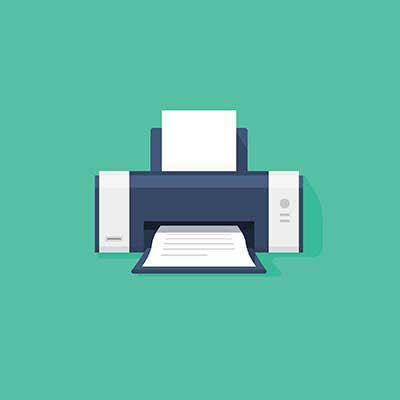State of the Printer Industry: 4 Big Things to Know
Printing has seen ups and downs over the past couple of years with pandemic turmoil. But overall, experts expect good growth in the future.

Overall, the printer industry has been facing some big impacts from the COVID-19 pandemic and related supply chain issues. While initial demand sent sales figures soaring, a backlog in available components and whole units started to pile up for all the major companies. Still, most of the hurt was felt on the consumer side of print while business printing held steady.
As the world enters a “new normal” phase after two years of pandemic shutdowns, the printing industry’s future is beginning to come into view. Andrew D. Paparozzi, chief economist for trade association Printing United Alliance, in a blog post warned that the commercial print industry may see a slowdown on the horizon. “As the economy slows, so will commercial printing,” he wrote in January. “Our preliminary forecast is for total printing industry sales (all sources) to grow … 5.2 (percent) to 6.2 (percent) for the full year. We expect comparable results for commercial printing.”
HP Inc.’s third quarter results showed some softening on the commercial print side – with printing net revenue down 6 percent year-over-year and commercial printing units down 15 percent year over year. HP is responding with a renewed focus on “as-a-service” offerings for business printers along with new offerings geared toward the small- and medium-sized business (SMB) market.
CRN takes a look at four trends in the printer business:
Subscription Models On Rise
An HP Inc.-conducted survey showed 80 percent of small businesses rely on printing while 55 percent said they don’t have time to manage the technology.
Vivian Chow, HP’s global head of product and portfolio management for HP’s print hardware systems, touted HP+ as a beneficial service offering for channel partners. “One thing we hear from channel partners and from small businesses is as much as they don’t have time to manage the printer, they often don’t have time to research the printer as well – and they often look to that channel partner as their trusted IT adviser,” she told CRN during an interview.
Bridgewater, N.J.-based printer vendor Brother USA touted its new printer subscription service at Xchange 2022. David Fisher, senior sales manager for the VAR channel for Brother USA. “This (hybrid) working environment has really given us an opportunity to address some changing needs with print and documents as well,” he said. The program includes hardware, supplies, services and support.
Multi-Function Printers Gain Traction
The multi-function printer (MFP) can be an all-in-one solution for many businesses, offering print, copy, fax, scanning and photocopying in one machine. According to research firm Proficient Market Insights, North America holds the title for most MFPs sold, followed by Europe and China. Manufacturers range from large multinational corporations to privately owned firms – but the leaders in this burgeoning market are HP, Ricoh, Canon, Epson and Brother, which accounted for 60 percent of the global market share in 2019, according to Proficient Market Insights.
Proficient says the MFP market is projected to reach $2.2 billion in revenue by 2026 with an annual growth rate of 2.5 percent expected despite pandemic-fueled market slowdowns.
According to another report from Technavio, the healthcare industry is fueling big sales in the MFP market, that the firm expects double the market growth Proficient forecast, growing by $4.92 billion from 2020-2025. Market research firm Technavio said moves to digital printing could impact that final number, the but firm remains confident overall demand will stay solid.
Supply Chain
Supply chain is impacting every aspect of the IT channel and print business is certainly no exception. Partners and vendors are navigating increased demand against supply constraints.
In a blog post, Troy McGinnis, executive vice president for print services at PHASE:3, said supply chain was on shaky ground even before the pandemic. But the multiple global lockdowns had a lasting impact driving up costs for paper and ink and creating hardware shortages. “There are also shipping delays to contend with, not only from manufacturers but also with delivers of finished products to customers. Significan disruptions in the supply chain and a labor shortage made worse by the pandemic have caused many U.S. busineses to see delays in their print orders.”
McGinnis says companies need to plan ahead, understand pricing may increase, order stock materials, set expectations and budget, and lastly, factor in extra time when planning projects.
Digital Printing
Research firm Reportlinker says the digital printer market registered a compound annual growth rate of 6.56 percent for 2022-2027, making digital printing one of the fastest-growing segments of the sign industry. Companies are using advances in artificial intelligence (AI, machine learning, IoT, and data analytics) to personalize digital printing offerings.
Canon, for example in April announced the PRISMAcolor Manager solution, which can assist users in evaluating and monitoring print quality when using compatible printers. It’s a cloud-based solution that illustrates how the industry is using new technology in their digitization efforts. Other companies have made significant improvements in print manufacturing efficiency, time-efficient production and enhanced focus on supply chain management, Reportlinker says.
“The advanced technology of digital printing includes mild solvents and less-harmful chemicals than the ones used in conventional printing technologies, like solid ink printing and offset printing,” the report says. “Hence, the demand for digital printing solutions is growing in the printed electronics market, increasing the focus on green printing and cost-effective production.”